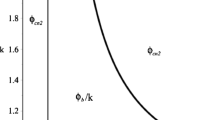Abstract
This study examines the optimal use of tariff policy in response to a change in both the number and market behavior of domestic firms. The paper demonstrates that under certain demand conditions, optimal trade policy may require an increase in tariffs in response to an increase in consolidation or collusion among domestic firms.
Similar content being viewed by others
References
Brander, J.A. and B.J. Spencer (1984a). “Tariff Protection and Imperfect Competition.” In Henryk Kierzkowski (ed.),Monopolistic Competition and International Trade. Oxford: Oxford University Press, pp. 194–206.
Brander, J.A. and B.J. Spencer (1984b) “Trade Warfare: Tariffs and Cartels,”Journal of International Economics 16, 227–242.
Buffie, E.F. and P.T. Spiller (1986) “Trade Liberalization in Oligopolistic Industries: The Quota Case,”Journal of International Economics 20, 65–81.
Cheng, L.K. (1988) “Assisting Domestic Industries Under International Oligopoly: The Relevance of the Nature of Competition to Optimal Policies,”American Economic Review 78, 746–758.
Cowan, S.B. (1989) “Trade and Competition Policies for Oligopolies,”Weltwirtschaftliches Archiv 125, 464–483.
Dixit, A. (1984) “International Trade Policy for Oligopolistic Industries,”Economic Journal 94, 1–16.
Dixit, A. (1988) “Anti-Dumping and Countervailing Duties Under Oligopoly,”European Economic Review 32, 55–68.
Eaton, J. and G.M. Grossman (1986) “Optimal Trade and Industrial Policy Under Oligopoly,”Quarterly Journal of Economics 51, 383–406.
Helpman, E. and P.R. Krugman (1989)Trade Policy and Market Structure. Cambridge: MIT Press.
Horstman, I.J. and J.R. Markusen (1986) “Up the Average Cost Curve: Inefficient Entry and the New Protectionism,”Journal of International Economics 20, 225–247.
Hwang, H. and C. Mai (1988) “On the Equivalence of Tariffs and Quotas Under Duopoly: A Conjectural Variations Approach,”Journal of International Economics 24, 373–380.
Jones, R.W. (1987) “Trade, Taxes and Subsidies with Imperfect Competition,”Economics Letters 23, 375–379.
Kowaiczyk, C. (1990) “Monopoly and Trade Policy,” National Bureau of Economic Research, Working Paper No. 3475.
Ordover, J.A. and R.O. Willig (1986) “Perspectives on Mergers and World Competition.” In Ronald E. Grieson (ed.),Antitrust and Regulation. Lexington, Mass.: D.C. Health, pp. 201–218.
Seade, J. (1980) “On the Effects of Entry,”Econometrica 48, 479–489.
Seade, J. (1988) “Profitable Cost Increases and the Shifting of Taxation: Equilibrium Responses of Markets in Oligopoly,” Working Paper, University of Warwick.
Venables, A.J. (1985) “Trade and Trade Policy with Imperfect Competition: The Case of Identical Products and Free Entry,”Journal of International Economics 19, 1–20.
Author information
Authors and Affiliations
Rights and permissions
About this article
Cite this article
Herander, M.G. Optimal trade policy in the presence of changing market structure. Open Econ Rev 4, 235–245 (1993). https://doi.org/10.1007/BF01000043
Issue Date:
DOI: https://doi.org/10.1007/BF01000043




